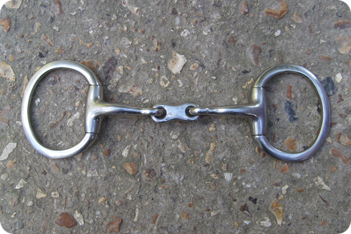

Snaffle
The snaffle bit is one of the most widely used bits due to the many different varieties that are available. A snaffle bit is one which contains a mouthpiece and bit rings.
Snaffle Action
Snaffle bits apply pressure upon the bars, corners, tongue and in some cases the sides of the face.
Snaffle Mouthpieces
There are a number of mouthpieces available that vary in both thickness and design:
- Single Jointed Snaffle
Single jointed bits have one central link going across the mouthpiece giving one point of pressure on the surface of the tongue, so that as the reins are used the bit begins to close causing a nutcracker action to take place upon the surface of the tongue. - Double Jointed Snaffle
Double jointed bits are made up of two links going across the mouthpiece, when pressure from the reins is applied the nutcracker action occurs upon the tongue over where the two links are positioned. The severity of the double joint will depend on the middle section of the mouthpiece:- The French Link for example is a gently curved middle portion that when the rein is applied and the nutcracker action comes into play over the the central link and will apply mild pressure across the tongue.
- The Dr. Bristol on the other hand has a straight and more angled edge to it which when rein pressure is applied will cause a more severe point of pressure upon the tongue increasing the severity of the bits action.
- Multiple Links
A bit made up of multiple links will apply a variety of pressure points upon the tongue. - Low Port or Mullen Mouth Snaffle
A snaffle bit that is ported will curve upwards allowing plenty of room for the horses tongue, when the rein is applied the pressure will be applied across the surface the tongue and on the bars of the mouth. This type of bit is particularly useful for horses who have very fleshy tongues. - Straight Bar Snaffle
The mouthpiece of a straight bar is as it sounds a single bar that contains no links and attaches directly to the rings. - Twisted
The mouthpiece contains either one or more twists and is considered to be a more severe bit due to the pressure that the twists will apply on the tongue when the rein is applied. The pressure of the twisted mouthpiece increases if there is a single joint in the middle and if the twists themselves are very thin. - Roller Mouthpiece
Roller snaffles contain moveable sections that literarily roll across the horses tongue and help the horse to relax their mouths and play with the bit helping to prevent them form leaning or taking hold of the bit. Examples include the Cherry roller bit and the Magennis snaffle both of which have moveable rollers positioned within them.
Snaffle Rings And Cheeks
The mouthpiece attaches to rings at either side and it is from these rings that the bridle reins and cheek pieces are attached to. There are several types of rings available:
- Egg Butt Snaffle
The rings of an eggbut are fixed directly to the mouthpiece and cause the mouthpiece to sit relatively still in the horses mouth, which often suits horses who are light in their contact or those with sensitive mouths. - Loose Ring Snaffle
The rings are attached to the mouthpiece section through holes which allow the bit rings and mouthpiece to be able to move around in the horses mouth, loose rings are great for horses prone to leaning or taking hold of the bit. - Snaffle Cheeks
Bit cheeks form a side bar that sit at the side of the horses mouth, assisting with steering and preventing the bit from being pulled through the horses mouth. There are several different cheek variations:- Fulmer Cheek - The mouthpiece has both upper and lower side bars which are subsequently also attached to loose rings at either side, this allows the mouthpiece to remain mobile in the horses mouth as well as aiding turning control.
- Hanging Cheek - The hanging cheek comprises of an egg butt ring which is attached to the mouthpiece and forms the rein attachment and also a further ring that sits above it to which the cheek pieces of the bridle attach to. The hanging cheek remains fairly still in the horses mouth and the bits action applies more pressure to the bars of the mouth than other snaffles would as well as some poll pressure to help with lowering the head.
- Full Cheek - The mouthpiece attaches directly to both the upper and lower cheek bars and from here there is a ring for the reins and cheek pieces to be attached.
- Half Cheek - The half cheek has either an upper or lower section to the side cheek bar.
Snaffles Are Often Made Of
Snaffle Bits can be made of a number of different materials
and in some cases a combination of two, such as:
- Copper - copper bits can help encourage salivation.
- Sweet Iron - sweet iron also encourages salivation due to its sweet taste.
- Rubber - Rubber bits although soft on the horses mouth, some bits especially vulcanite can be a little bit on the chunky side and so may not suit every horse. Rubber bits are often used on youngsters due to their softer nature
- Stainless Steel - stainless steel bits are very durable and the majority of horses go very well in.
Snaffle Sizing
Bits are measured from between the mouthpiece rings and are usually available in sizes ranging from 3, 3.5, 4, 4 1/4, 4.5, 4 3/4, 5, 5 1/4 , 5.5, 5 3/4 and 6 inches.